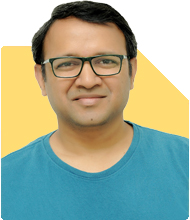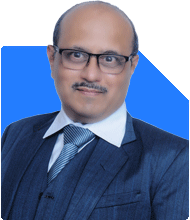Ramalingam Kalirajan |10894 Answers |Ask -Follow
Mutual Funds, Financial Planning Expert - Answered on Jul 05, 2024
He has an MBA in finance from the University of Madras and is a certified financial planner.
He is the director and chief financial planner at Holistic Investment, a Chennai-based firm that offers financial planning and wealth management advice.... more

Hello sir....my age is 35... I earn only 20 k pm...and my sip only 1000 rs....how to make 1 CR before (60 age)
Importance of Early and Regular Investments
Starting early and investing regularly is crucial for building wealth over time. You have 25 years until you turn 60, which gives you a significant advantage. The power of compounding can greatly enhance your returns, especially over a long investment horizon.
Compounding: The Eighth Wonder of the World
Compounding allows your investment returns to generate additional returns. Over time, this leads to exponential growth. The earlier you start and the more consistently you invest, the greater the benefits of compounding.
Evaluating Your Current Investment Strategy
Your current SIP of Rs. 1,000 is a good start. However, to reach Rs. 1 crore, you need to increase your investment amount over time. Let's explore how to optimize your savings and investment strategy to achieve your goal.
Boosting Your Investment Capacity
Increasing Income
Look for opportunities to increase your income. This could be through skill enhancement, taking on additional part-time work, or seeking promotions and salary increments. Increasing your income will provide more funds for investment.
Reducing Expenses
Analyze your monthly expenses and identify areas where you can cut costs. Even small savings can significantly boost your investment capacity over time. Creating a budget can help you track and manage your expenses effectively.
Gradual Increase in SIP
Aim to gradually increase your SIP amount as your income grows. Even a small increase in your monthly SIP can have a significant impact over the long term. For instance, increasing your SIP by Rs. 500 annually can greatly enhance your corpus by the time you reach 60.
Strategic Allocation of Investments
To achieve your financial goal, it's crucial to allocate your investments wisely. Diversification across various mutual fund categories can help manage risk and optimize returns.
Equity Mutual Funds
Equity mutual funds should form the core of your investment portfolio due to their high return potential. Within equity funds, diversification is essential.
Large-Cap Funds: These funds invest in large, well-established companies. They offer stability and moderate returns.
Mid-Cap Funds: These funds invest in mid-sized companies with higher growth potential. They are riskier but can provide higher returns.
Small-Cap Funds: These funds invest in smaller companies with the highest growth potential and risk.
Debt Mutual Funds
Debt funds provide stability and reduce overall portfolio risk. They are suitable for medium-term goals and act as a cushion against market volatility.
Short-Term Debt Funds: Less affected by interest rate changes, providing steady returns.
Long-Term Debt Funds: Offer higher returns with some interest rate risk.
Hybrid Mutual Funds
Hybrid funds invest in a mix of equity and debt. They offer a balanced approach, providing growth potential and stability.
Aggressive Hybrid Funds: Primarily invest in equity but have a significant debt component for stability.
Conservative Hybrid Funds: Higher debt component, offering more stability and moderate growth.
Advantages of Mutual Funds
Professional Management
Mutual funds are managed by professional fund managers who make informed decisions based on extensive research and market analysis. Their expertise can enhance your investment returns.
Diversification
Mutual funds offer diversification, spreading your investment across various assets. This reduces risk as poor performance in one asset is balanced by better performance in another.
Liquidity
Mutual funds are highly liquid. You can buy and sell mutual fund units on any business day, providing flexibility to access your money when needed.
Power of Compounding
Mutual funds benefit from the power of compounding. Reinvesting your returns allows your investment to grow exponentially over time.
Assessing Risks and Mitigating Them
Market Risk
Equity funds are subject to market risk. The value of your investment can fluctuate with market conditions. However, long-term investment in equity funds usually mitigates this risk.
Interest Rate Risk
Debt funds are affected by changes in interest rates. Rising interest rates can reduce the value of existing bonds in a debt fund's portfolio. Short-term debt funds are less affected by this risk.
Credit Risk
Debt funds also face credit risk, the risk of default by issuers of the bonds they hold. Investing in high-quality debt funds can reduce this risk.
Disadvantages of Index Funds
While index funds track a specific index and offer low costs, they cannot outperform the market. Actively managed funds aim to beat the market through strategic investments. Fund managers of actively managed funds use their expertise to select high-potential stocks, offering better returns.
Benefits of Investing Through Certified Financial Planners
Investing through a Certified Financial Planner (CFP) has advantages over direct investments. CFPs provide personalized advice based on your financial goals, risk tolerance, and investment horizon. They help you select the right mutual funds, monitor your investments, and make adjustments as needed. Their expertise ensures your investments are aligned with your financial goals.
Your commitment to investing despite a modest income is admirable. It reflects a strong sense of financial responsibility and foresight. Your dedication to building a secure financial future is inspiring and deserves appreciation.
Balancing financial commitments while planning for future goals is challenging. Your efforts to secure a strong financial foundation for yourself and your loved ones reflect a deep sense of responsibility. It's clear you care about achieving financial independence and stability.
Final Insights
Reaching Rs. 1 crore by age 60 is achievable with disciplined investing and strategic planning. Focus on increasing your income, reducing expenses, and gradually increasing your SIP amount. Diversify your investments across equity, debt, and hybrid mutual funds to balance risk and return.
Your proactive approach to financial planning sets a strong example. With careful management and the right investments, you can achieve significant financial growth and security.
Best Regards,
K. Ramalingam, MBA, CFP,
Chief Financial Planner,
www.holisticinvestment.in
You may like to see similar questions and answers below
Ramalingam Kalirajan |10894 Answers |Ask -Follow
Mutual Funds, Financial Planning Expert - Answered on Jun 22, 2024
Ramalingam Kalirajan |10894 Answers |Ask -Follow
Mutual Funds, Financial Planning Expert - Answered on Jul 30, 2024
Milind Vadjikar | Answer |Ask -Follow
Insurance, Stocks, MF, PF Expert - Answered on Sep 04, 2024
Ramalingam Kalirajan |10894 Answers |Ask -Follow
Mutual Funds, Financial Planning Expert - Answered on Sep 27, 2024
Ramalingam Kalirajan |10894 Answers |Ask -Follow
Mutual Funds, Financial Planning Expert - Answered on Oct 22, 2024
Patrick Dsouza |1429 Answers |Ask -Follow
CAT, XAT, CMAT, CET Expert - Answered on Dec 16, 2025
Nayagam P P |10858 Answers |Ask -Follow
Career Counsellor - Answered on Dec 16, 2025
Nayagam P P |10858 Answers |Ask -Follow
Career Counsellor - Answered on Dec 16, 2025
Samraat Jadhav |2510 Answers |Ask -Follow
Stock Market Expert - Answered on Dec 16, 2025
Samraat Jadhav |2510 Answers |Ask -Follow
Stock Market Expert - Answered on Dec 16, 2025
Nayagam P P |10858 Answers |Ask -Follow
Career Counsellor - Answered on Dec 16, 2025
Nayagam P P |10858 Answers |Ask -Follow
Career Counsellor - Answered on Dec 16, 2025
Ramalingam Kalirajan |10894 Answers |Ask -Follow
Mutual Funds, Financial Planning Expert - Answered on Dec 16, 2025
Nitin Narkhede |113 Answers |Ask -Follow
MF, PF Expert - Answered on Dec 15, 2025
Nitin Narkhede |113 Answers |Ask -Follow
MF, PF Expert - Answered on Dec 15, 2025



























